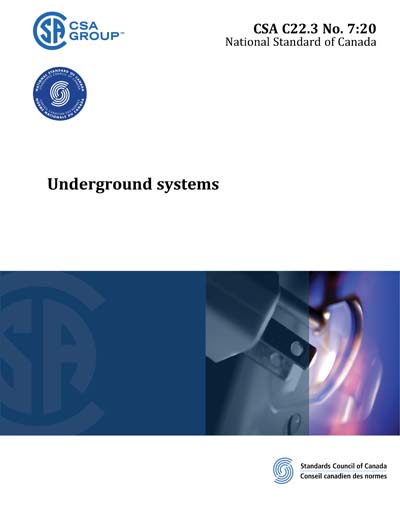Most recent
CSA C22.3 No. 7-2020
Underground systems
Preface This is the sixth edition of CSA C22.3 No. 7, Underground systems , one of a series of Standards issued under the Canadian Electrical Code, Part III. It supersedes the previous editions published in 2015, 2010, 2006, 1994, and 1986. This edition includes the following major changes: a) Clause 1 has been revised, with clarification on communication systems, and also where the installations or equipment are inside buildings or sections of buildings. b) Reference publications have been updated. c) The definitions for backfill, effectively grounded, grounding, live, subsurface box, and treated plank have been revised; definitions for terms no longer used in the Standard have been removed; and definitions for new terms including metallic, pad, pad-mounted, non-main line track, rebar, service (consumer’s and supply), and subsurface chamber access opening have been included in the Standard. d) Existing sections with requirements have been updated dealing with i) random separation between supply and communication cables in a common trench; ii) settling; iii) cable pulling tension; iv) construction of vaults, subsurface chambers, and subsurface boxes; v) above-ground equipment; vi) installations on railway rights-of-way; vii) electrical protection — direct-buried system; viii) grounding and bonding; and ix) records and identification of underground plant. e) New clauses have been included dealing with i) separation from natural gas or propane equipment; ii) settling; iii) crossings under heavy rail tracks; and iv) crossings under light rail tracks. f) The Clause on common trenches has been modified to permit installation of communication cables in the lower position relative to supply cables in a joint trench subject to agreement among the parties involved. g) Material has been added to Annex A dealing with i) grounding and bonding cable shields/sheaths; ii) settling; iii) cable pulling tension (duct structure); iv) seismic withstand; v) installation on railway rights-of-way; vi) crossings; vii) horizontal distance from railways; viii) grounding and bonding; and ix) Figures A.3 and A.4. h) Some clauses have been restructured or reordered to improve the readability of the Standard. This Standard has been developed in compliance with Standards Council of Canada requirements for National Standards of Canada. It has been published as a National Standard of Canada by CSA Group. Scope 1.1 This Standard applies to the lines and equipment associated with underground electric supply and communication systems located outside fenced supply stations and buildings, and also where the installations or equipment are inside buildings or sections of buildings where they are employed by a utility of a) an electric system; b) a communication system; or c) a community antenna distribution system in the exercise of its function as a utility. This Standard, which forms part of the Canadian Electrical Code, Part III, covers the requirements for construction of underground systems and includes electric supply and communication circuits that are installed alone, in joint use, or in proximity to each other or other facilities. Note: See CSA C22.3 No. 61936-1 for installations within fenced or indoor supply stations. 1.2 Existing installations meeting the requirements of prior editions of this Standard need not be modified to comply with this edition of the Standard, except as might be required for safety reasons by the authority having jurisdiction. 1.3 The requirements of this Standard do not constitute complete construction specifications but stipulate the minimum design requirements with regard to a) safety to persons; b) continuity of service; and c) protection of property. 1.4 The selection, design, and installation of supply transmission cables ( 69 kV) are not addressed in this Standard. 1.5 Conditions not covered by this Standard are governed by equivalent Standards in common use or by the authority having jurisdiction. 1.6 In some cases, requirements are written for specific types of construction. This does not preclude the use of other types of construction arising out of continuing advancements in the field, provided that engineering representatives can demonstrate the safety and suitability of these alternatives. 1.7 The use of terms such as "where practical" is not intended to provide an opportunity for not meeting the minimum requirements of this Standard. When an alternative is not specified, the engineering solution that most closely approximates the preferred method is to be used. 1.8 In this Standard, "shall" is used to express a requirement, i.e., a provision that the user is obliged to satisfy in order to comply with the Standard; "should" is used to express a recommendation or that which is advised but not required; and "may" is used to express an option or that which is permissible within the limits of the Standard. Notes accompanying clauses do not include requirements or alternative requirements; the purpose of a note accompanying a clause is to separate from the text explanatory or informative material. Notes to tables and figures are considered part of the table or figure and may be written as requirements. Annexes are designated normative (mandatory) or informative (non-mandatory) to define their application.
Content Provider
CSA America, Inc. [csa]






